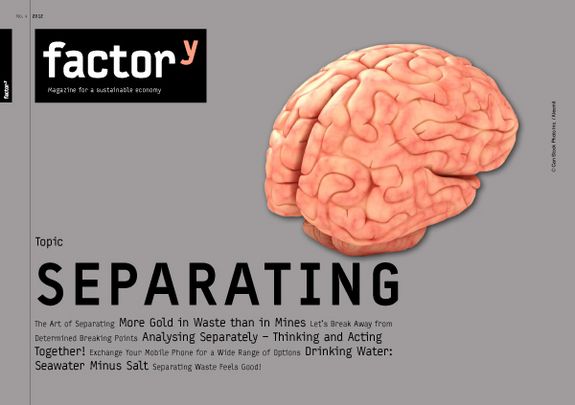Separating

The Art of Separating

Nowadays, people who separate either separate their waste, or break up with someone. Both things are difficult for us, which is why we like to postpone them. To separate waste or other things is referred to by grammar books as transitive, to separate yourself from something is reflexive. This reflexive dimension is what is most important for sustainable ways of living and for the success of all sustainability strategies – it is about shaping ourselves, not about us acting upon things. As the German philosopher Heidegger would say – it is about Dasein, not about stuff.
By Bernd Draser
Translated from the German by Stefan Helwig and Simon Varga
Why is it so difficult to separate yourself from something or someone? Because separation calls habits into question. Habits are comfortable because they, in fact, do not ask questions, but instead take place in an unreflected, effortless way. Habits are needed where we cannot afford to think about each and everything at every moment, that is to say in everyday life. But with our way of life – mass consumption – those unreflected routines congeal into a danger and the familiar 'it has always been like this' cannot be the way to go. In the course of the public dialogue, this type of thinking has been seen for many years now, but mostly as a rhetoric figure, not as an actual change in habits. Applying the famous greenwashing method, those habits are prettied up into customs with a bit of green whitewash. As a consequence, we sophists separate our waste rather than separating ourselves from our routines.
However, we would not be where we are now were it not for our ability to separate – even if it is anything but easy for us. Indeed, separating is part of an ancient cultural technique that French ethnologist Arnold van Gennep analysed with astonishing clarity in his 1909 work ‘The Rites of Passage’. According to van Gennep, tribal societies without written tradition consider the passage from one state to another dangerous. The old is exhausted, whereas the new is not yet established. This may refer to stages of life, such as the coming of age, marriage or death, but also to transfers of office, annual cycles, travel or the inauguration of buildings. This is where the cultural technique of separating has its place. In a first step, one has to let go of the old, exhausted, and worn out (rites of separation) and undertake the passage to the new in the subsequent period of transition (rites of transition), to return changed, renewed and strengthened to society in the third and last step (rites of incorporation).
Beauty Makes Sense
Rites of separation constitute a major act of substitution, and it is with sadness that they are performed. The rites of transition use the symbolism of death, because the old must die and be buried to give the new strength to live. The rites of incorporation are celebrations of birth and joy that give cause for delight after a dangerous transition has been achieved. Each of the three steps has created complex symbolisms, which used to be closely associated with mythical and religious stories and characters. It is through their highly symbolic nature that these dangerous transitions crystallise into aesthetic procedures that not only produce sense but also beauty for the eye.
This is what makes separation so hard for us. Since the industrial revolution, Western thought has strongly influenced lifestyles around the world. This process began more than 2500 years ago with the criticism of myths and rites. The Ionic philosophy of nature then launched a first wave of secularisation that has become more powerful ever since. This presents several advantages: humanitarianism, the deliverance from the burden of tradition, the allaying of fear through rationality. But there are also disadvantages, as one can see most clearly in our attitude towards death and dying. This most delicate of transitions is transferred to hospitals where it is discreetly managed by experts. Our only experience of death is that of a fictional one in television. By becoming critics of myths and rites and consuming them only in vulgarised forms, such as the cinematic journey of heroes, fan clubs or crude military initiation rites, we have allowed the art of separation to degenerate into something trivial.
Being the secularised critics that we are, we have forgotten about the intrinsic movement of separation, the circling. We are hardly capable of circular thinking; we are used to linear thinking (or dialectic thinking—but dialectics is linearity, only with a lot of swagger) that millennia of salvation history have engraved in our minds. Such gloomy thoughts traditionally call for a line from Hölderlin’s poem Patmos: “But where there is danger, / A rescuing element grows as well.”1 And indeed, to the extent to which religion was bound by the shackles of pure rationality in the 18th century, its corrective—art—took the place formerly held by religion, especially in regard to the performative aesthetics of its rites. Between 1750 and 1800, aesthetic discourse exploded and art has been attributed a universal power of redemption ever since. According to contemporary discourses on the art of living, the reductionist aesthetic of the 20th century with its heroic avant-garde has then opened our senses to another point: the aesthetically pleasing (in the past, one would have said “the beautiful”) is not attractive when nothing more can be added to it, but when there is nothing more that can be taken away to make it even more attractive.
Aesthetic transition
Applied to our lifestyles, this aesthetic criterion combines aesthetic quality with what is sustainable and thus necessary in a strikingly simple way. What is charming about this combination is the fact that it renders the unpleasant moral rigorism—which hinders sustainable lifestyles rather than fostering them—obsolete.
The art of separation belongs to the fine arts. It is as old as human culture itself. It is an anthropological universal, and thus a resource that is not just abundant but in fact unlimited. And it produces sense, because this is what rituals do—they produce sense and symbols. Therefore we can tell stories that are both new and very old. And we need these stories of a successful life, of a life that successfully manages separation, transition, incorporation and transformation, because without them, no sustainability strategy can be truly credible. While sustainability is today mainly seen in terms of an economic and technological challenge, sustainability efforts have a better chance to succeed if the aesthetic, symbolic domain—formerly the domain of rites—is included. So, do we have to become traditional? Or even religious? No. We can stay secular, as long as we become more aesthetic.
Bernd Draser teaches philosophy at ecosign/Academy for Design, Cologne. For factory he has written about Participation.
More articles to the topic of Separating with expressive numbers and citations, nicely illustrated and readable on screens and tablets you will find in our PDF magazine Separating.
Beiträge online
SEPARATING

- The art of separation
- More Gold in Waste than in Mines
- Let’s Break Away from Determined Breaking Points
- Analysing Separately – Thinking and Acting Together!
- Tausche Handy gegen großes Menü
- Meerwasser minus Salz. Trennen fürs Trinkwasser.
News zum Thema
- 06/2014 | Separating: New Topic of Factory-Magazine
- 08/2013 | A Map for sustainable shopping in NRW
Themen
- The Domino Effect: the Mobility Transition as an Engine for the ‘Great Transformation’
- Cities Use the Space
- Decarbonization by 2030
- The fear of biting the hand that feeds you
- Where investing is a pleasure
- Why divestment is going to change the world
- A Robin Hood tax for climate protection
- May the Force Be with Us
- Modern Strategies
- The prerogative of interpreting the future now lies with the companies involved in climate protection”
- From Negotiating to Trading Equitably
- Can a donkey be tragic?
- Rethink rather than rebound: a sufficiency revolution must precede the efficiency revolution
- On Rebound, Prebound and Performance Gaps
- So Let Us Seize Power Then!
- With Common Property Against Political Failure
- So Let Us Seize Power Then!
- The Comforting Beauty of Failure
- “It Is Not Impossible at All.“
- Resource-light shopping
- Men Have Not Stopped Giving the Advantage to Women – So Far
- Toothpaste for Princesses and Soup for Pirates
- It is about equality
- A nice day
- Initiative instead of frustration
- The right ingredients
- Resilient for Life
- Not only, but also
- Appreciation – more please!
- Worth more than money
- Learning to value the value of goods
- Worth and Values
- The Transformative Power of Science
- Historically effective: How innovation and technology transform
- The Disappearance of Products
- Growing Older 101
- Columbus’ Egg
- It Works! In Theory at Least ...
- What If...?
- Analysing Separately – Thinking and Acting Together!
- Let’s Break Away from Determined Breaking Points
- More Gold in Waste than in Mines
- The art of separation
- Should you really DIY?
- The Aesthetics of Do-It-Yourself
- Standing on One’s Own Feet
- From the handaxe to desktop fabrication
- Using Shares to Survive the Crisis
- When Citizens participate
- Possess to Participate
- The Right Growth at the Right Time
- Gunter Pauli and Blue Economy
- When Sustainability Grows
- How we treat Growth
- Illusions about Growth

